Electricity transmission without wires - from the beginning to the present day
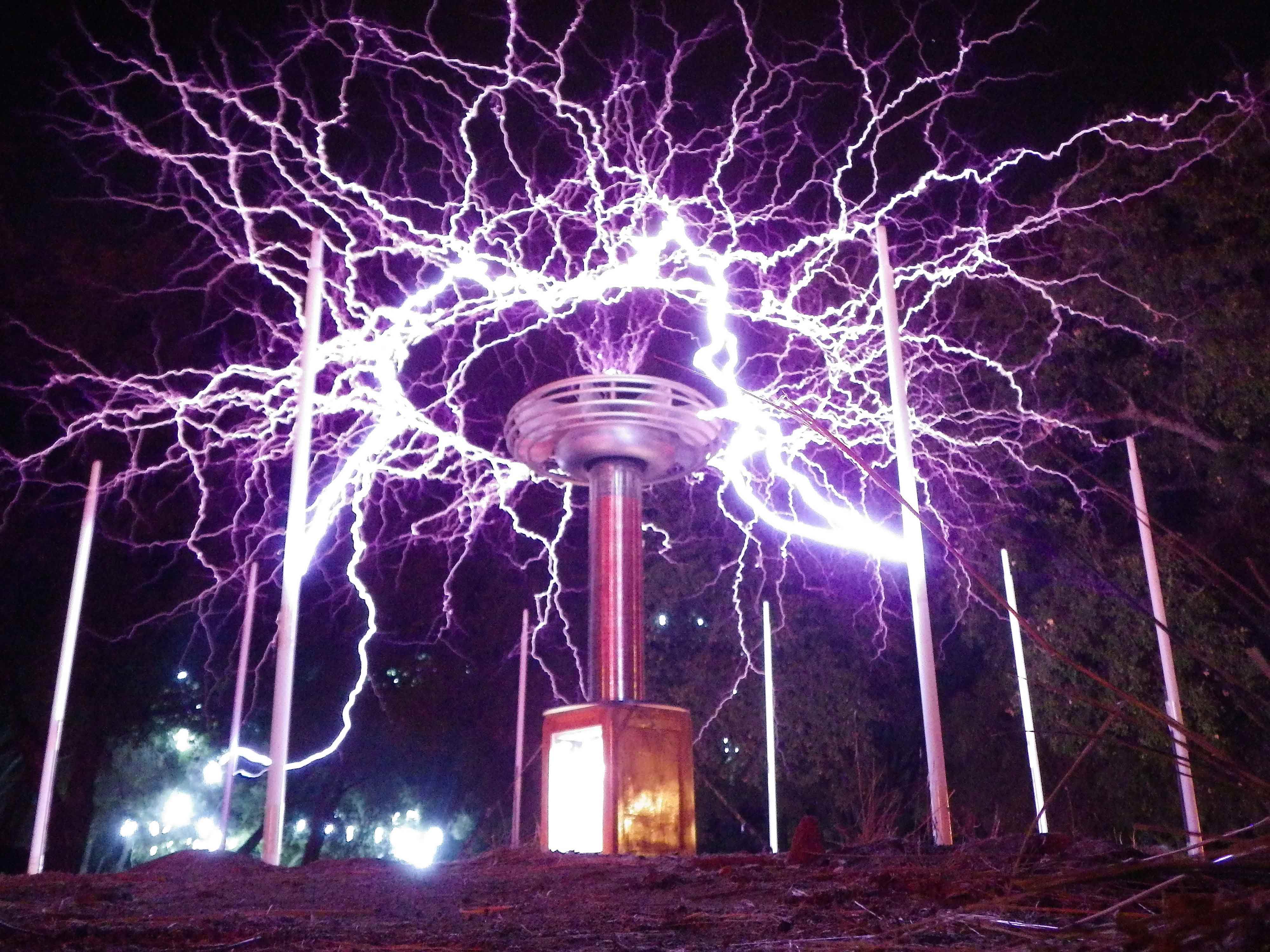
Electric power transmission without wires is a method of transmitting electric energy without the use of conductive elements in an electrical circuit.
At the end of the 19th century, the discovery that electricity could be used to make a light bulb glow caused an explosion of research aimed at finding the best way to transmit electricity.
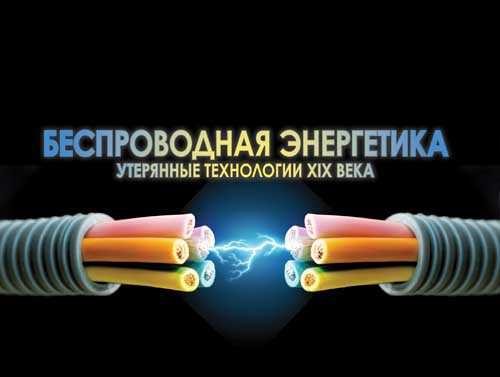
Wireless energy transmission was actively studied at the beginning of the 20th century, when scientists paid great attention to the search for various ways of wireless energy transmission. The goal of the research was simple - to generate an electric field in one place so that it could then be detected by devices at a distance. At the same time, attempts were made to supply energy at a distance of not only highly sensitive sensors for voltage detection, but also significant energy consumers. So, in 1904 at the St. The Louis World's Fair was awarded the prize for the successful launch of an aircraft engine with a capacity of 0.1 horsepower, carried out at a distance of 30 m.
The gurus of "electricity" are known to many (William Sturgeon, Michael Faraday, Nicolas Joseph Callan, James Clerk Maxwel, Heinrich Hertz, Mahlon Loomas, etc.), but few people know that the Japanese researcher Hidetsugu Yagi used an antenna to transmit energy. In February 1926, he published the results of his research, in which he described the structure and method of tuning the Yagi antenna.
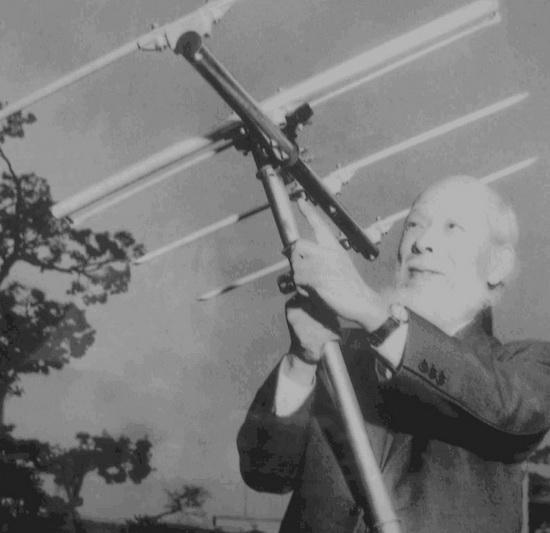
Note: I haven’t mentioned consciously about Nikola Tesla : many have been written by many.
Very serious work and projects were carried out in the USSR during the period 1930-1941 and in parallel in the Drittes Reich . Naturally, mainly for military purposes. Naturally, mainly for military purposes: the defeat of enemy forces, the destruction of military and industrial infrastructure, etc.
Serious work was also carried out in the USSR on the use of microwave radiation to prevent surface corrosion of metal structures and products.
But this is a different story. Again, you have to climb into the dusty attic.
One of the largest Russian physicists of the last century, Nobel laureate, academician Pyotr Leonidovich Kapitsadevoted part of his creative biography to the study of the prospects of using microwave oscillations and waves to create new and highly efficient energy transfer systems. In 1962, in the preface to his monograph, he wrote
“... I want to remind you that before coming to the service of power engineering, in the last century, electrical engineering dealt extensively only with telecommunication issues (telegraph, alarm, etc.). It is likely that history will repeat itself: now electronics is mainly used for radio communications, but its future lies in solving major energy problems . "
Of the long list of fantastic technical ideas implemented in the twentieth century, only the dream of wireless transmission of electrical energy continued to remain unfulfilled. Detailed descriptions of energy rays in science fiction novels teased engineers with their obvious need, and at the same time the practical complexity of the implementation.
But the situation gradually began to change for the better.
In 1964, an expert in microwave electronics, William C. Brown, first tested a device (helicopter model) capable of receiving and using microwave energy in the form of direct current, thanks to an antenna array consisting of half-wave dipoles, each of which is loaded with highly efficient Schottky diodes.
In 1964, William C. Brown demonstrated on CBS in the Walter Cronkite News program his helicopter model, which received enough energy for the flight from a microwave emitter.
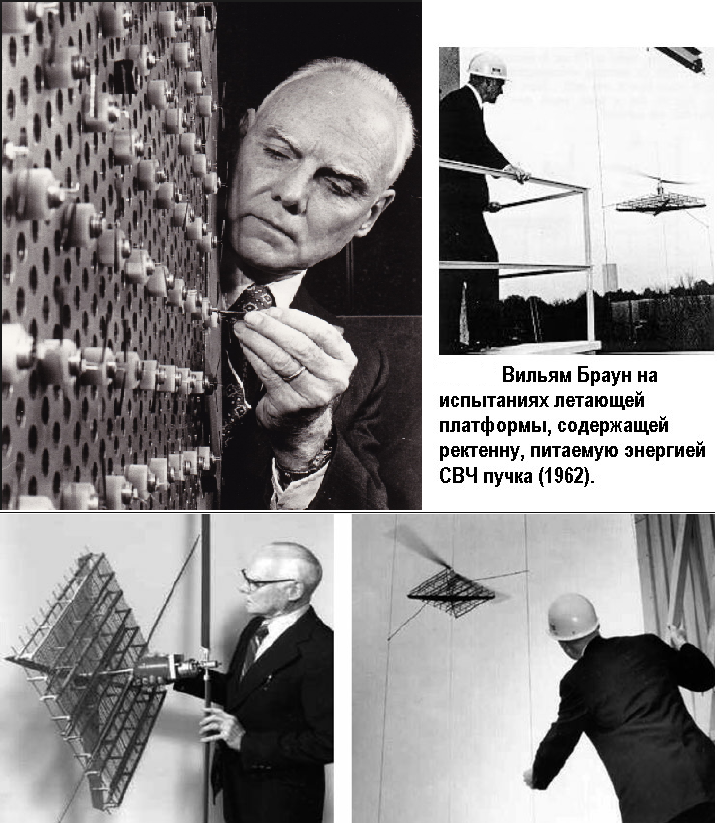
By 1976, William Brown had transferred microwave power of 30 kW to a distance of 1.6 km with an efficiency exceeding 80%.
Tests were conducted in the laboratory and commissioned by Raytheon Co.
Details (in English) read:
Microwave Power Transmission - IOSR Journals
The microwave powered Helicopter. William C. Brown. Raytheon Company.
In 1968, Peter E. Glaser, an American specialist in space research, proposed placing large solar panels in geostationary orbit, and transferring the energy they produce (at the level of 5-10 GW) to the Earth's surface with a well-focused microwave beam , then convert it into energy of direct or alternating current of technical frequency and distribute to consumers.
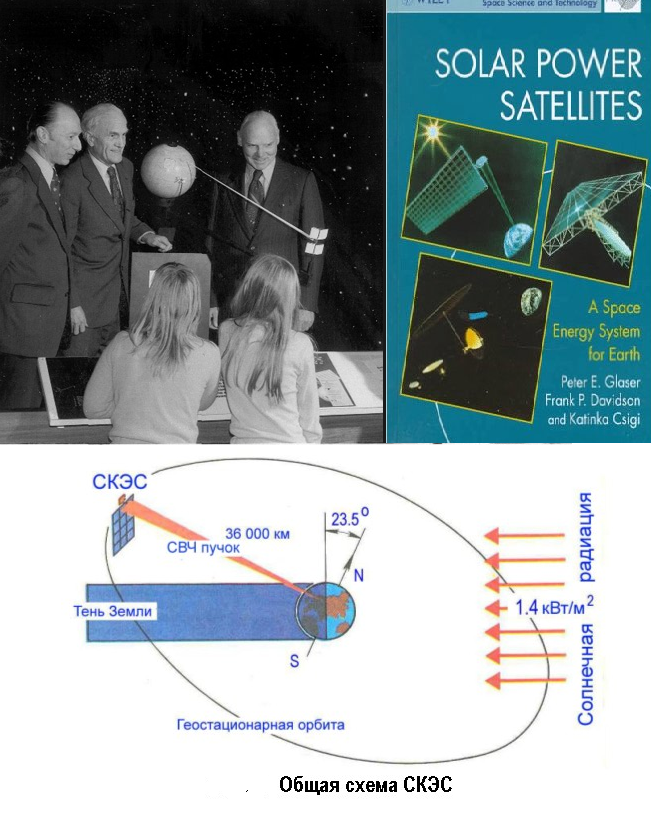
Such a scheme made it possible to use the intense flux of solar radiation existing in the geostationary orbit (~ 1.4 kW / sq.m.) And transmit the received energy to the Earth’s surface continuously, regardless of the time of day or weather conditions [2-12]. Due to the natural inclination of the equatorial plane to the ecliptic plane with an angle of 23.5 degrees, the satellite located in the geostationary orbit is illuminated by the flux of solar radiation almost continuously except for small periods of time near the days of the spring and autumn equinox when this satellite falls into the shadow of the Earth. These time intervals can be accurately predicted, and in total they do not exceed 1% of the total duration of the year.
The frequency of electromagnetic oscillations of the microwave beam should correspond to those ranges that are allocated for use in industry, scientific research and medicine. If this frequency is chosen to be 2.45 GHz, then meteorological conditions, including heavy cloud cover and heavy rainfall, practically do not affect the energy transfer efficiency. The 5.8 GHz range is tempting because it makes it possible to reduce the size of the transmitting and receiving antennas. However, the influence of meteorological conditions here already requires further study.
The current level of development of microwave electronics allows us to talk about a rather high value of the energy transfer efficiency of a microwave beam from a geostationary orbit to the Earth's surface - about 70-75%. In this case, the diameter of the transmitting antenna is usually chosen equal to 1 km, and the ground rectenna has dimensions of 10 km x 13 km for a latitude of 35 degrees. SKES with an output power level of 5 GW has a radiated power density in the center of the transmitting antenna of 23 kW / sq.m., In the center of the receiving antenna - 230 W / sq.m.
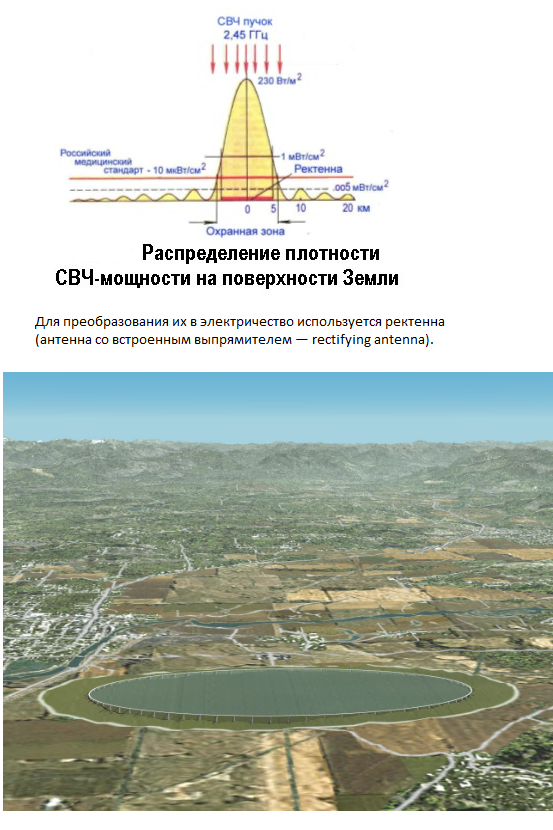
Various types of solid-state and vacuum microwave generators for the transmitting antenna of the SCES were investigated. William Brown showed, in particular, that magnetrons well developed by the industry, designed for microwave ovens, can also be used in transmitting antenna arrays of SCES, if each of them is equipped with its own negative feedback loop in phase with respect to the external synchronizing signal (so called, Magnetron Directional Amplifier - MDA).
Rectenna is a highly efficient receiving and converting system, however, the low voltage of the diodes and the need for their serial switching can lead to avalanche breakdowns. The cyclotron energy converter can significantly eliminate this problem.
The SCES transmitting antenna can be a back-emitting active antenna array based on slotted waveguides. Its rough orientation is carried out mechanically, for accurate guidance of the microwave beam, a pilot signal is used, emitted from the center of the receiving rectenna and analyzed on the surface of the transmitting antenna by a network of corresponding sensors.
From 1965 to 1975 The research program led by Bill Brown was successfully completed, demonstrating the possibility of transferring 30 kW of power over a distance of more than 1 mile with an efficiency of 84%.
In 1978-1979, the first state research program aimed at determining the prospects of SCES was carried out in the United States under the leadership of the Department of Energy (DOE) and NASA (NASA).
In 1995-1997, NASA again returned to discussing the prospects for SCES, building on the progress of technology achieved by then.
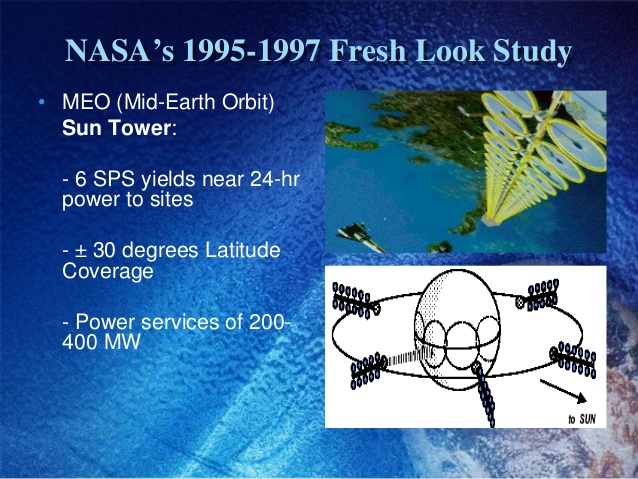
Research was continued in 1999–2000 ( Space Solar Power (SSP) Strategic Research & Technology Program ).
The most active and systematic research in the field of SCES was carried out by Japan. In 1981, under the guidance of professors M.Nagatomo Makoto and S.Sumaki Susumu at the Space Research Institute of Japan, research was started on the development of a prototype SKES with a power level of 10 MW, which could be created using existing rocket carriers. The creation of such a prototype allows you to accumulate technological experience and prepare the basis for the formation of commercial systems.
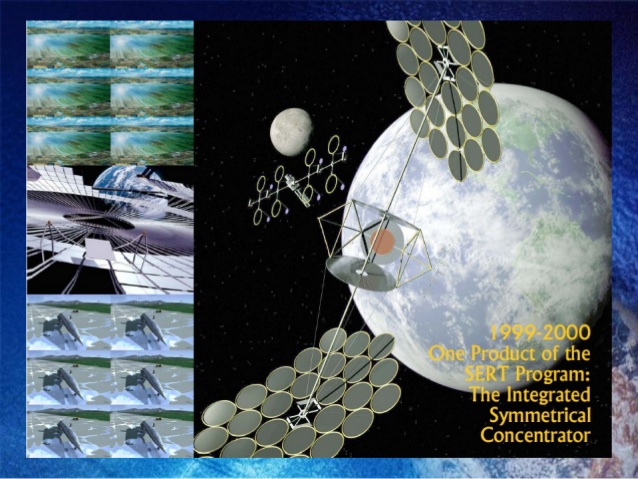
The project was named SKES2000 (SPS2000) and gained recognition in many countries of the world.
In 2008, Marin Soljačić, assistant professor of physics at the Massachusetts Institute of Technology (MIT), was awakened from a sweet sleep by the insistent shouting of a mobile phone. “The phone didn’t stop, demanding that I set it to charge,” says Soljacic. Tired and not about to get up, he began to dream that the phone, being at home, begin to charge on its own .
So WiTricity and WiTricity corporation appeared.
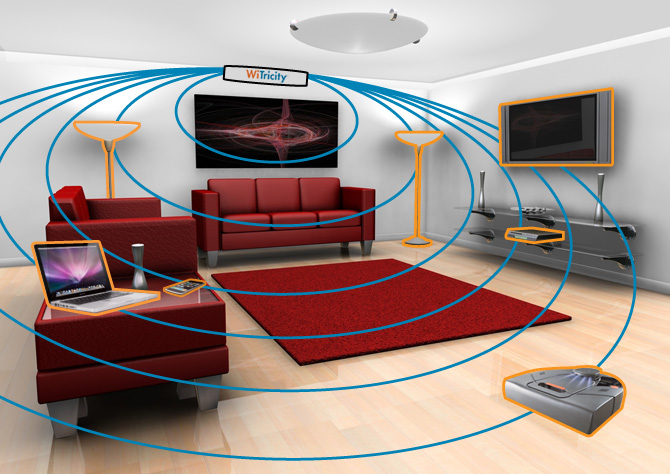
In June 2007, Marin Soljačić and several other researchers at the Massachusetts Institute of Technology announced the development of a system in which a 60 W bulb was supplied from a source located at a distance of 2 m, with an efficiency of 40%.
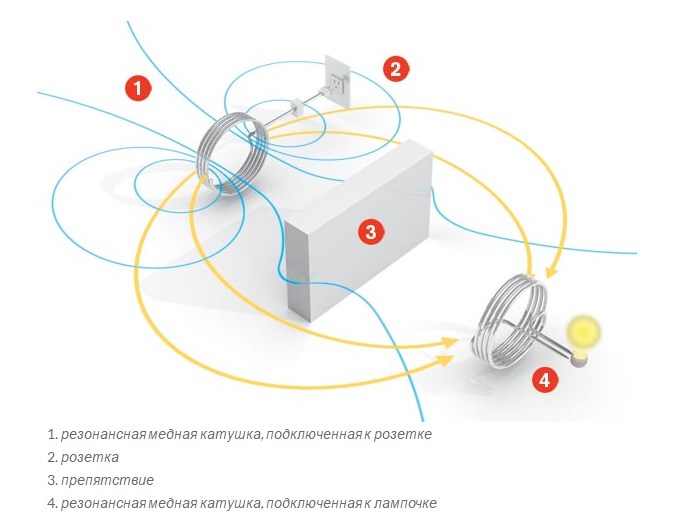
According to the authors of the invention, this is not a “pure” resonance of coupled circuits and not a Tesla transformer with inductive coupling. The radius of energy transfer today is a little more than two meters, in the future - up to 5-7 meters.
In general, scientists tested two fundamentally different schemes.
1. In an induction coil or electric transformer that has a metal or air core, energy is transferred through a simple electromagnetic connection called magnetic induction. Using this method, the transmission and reception of energy became feasible at a considerable distance, but in order to obtain significant voltage in a similar way, it was necessary to arrange two coils very close.
2. If magnetic resonance coupling is used, where both inductors are tuned to a mutual frequency, significant energy can be transmitted over a considerable distance.
Similar technologies are feverishly developed by other companies: Intel demonstrated its WREL technology with an energy transfer efficiency of up to 75%. In 2009, Sony demonstrated the operation of a television without a network connection. Only one circumstance is alarming: regardless of the transmission method and technical tricks, the energy density and field strength in the rooms should be high enough to power devices with a power of several tens of watts. According to the developers themselves, information on the biological effects on humans of such systems is not yet available. Given the recent appearance, and a different approach to the implementation of energy transmission devices, such studies are yet to come, and the results will not appear soon. And we can judge their negative impact only indirectly. Something will disappear from our homes again, like,
In 2010, the Haier Group, a Chinese home appliance manufacturer, unveiled at CES 2010 its unique product, a fully wireless LCD TV, based on research by Professor Marina Solyachich on wireless power transmission and wireless home digital interface ( WHDI ).
In 2012-2015 University of Washington engineers have developed a technology that allows you to use Wi-Fi as an energy source to power portable devices and charge gadgets. The technology has already been recognized by Popular Science magazine as one of the best innovations of 2015. The ubiquity of wireless data technology has itself revolutionized the world. And now it’s the turn of wireless transmission of energy through the air, which developers from the University of Washington called PoWiFi (from Power Over WiFi).
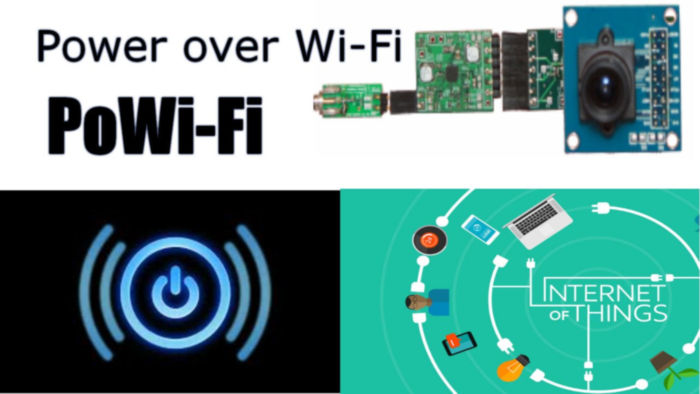
At the testing stage, the researchers were able to successfully charge small-capacity lithium-ion and nickel-metal hydride batteries. Using the Asus RT-AC68U router and several sensors located at a distance of 8.5 meters from it. These sensors just convert the energy of the electromagnetic wave into direct current with a voltage of 1.8 to 2.4 volts, which are needed to power the microcontrollers and sensor systems. A feature of the technology is that the quality of the working signal does not deteriorate. It is enough to reflash the router, and it will be possible to use it as usual, plus supply power to low-power devices. At one of the demonstrations, a small low-resolution covert surveillance camera was successfully powered, located at a distance of more than 5 meters from the router. Then, the Jawbone Up24 fitness tracker was charged at 41%, it took 2.5 hours.
To tricky questions about why these processes do not adversely affect the quality of the network communication channel, the developers answered that this is possible due to the fact that the flashed router, during its work, sends energy packets to the channels that are not transmitting information. They came to this decision when they discovered that during periods of silence energy simply flows out of the system, and yet it can be used to power low-power devices.
During the research, the PoWiFi system was placed in six houses, and invited residents to use the Internet as usual. Download web pages, watch streaming video, and then tell what has changed. As a result, it turned out that the network performance has not changed in any way. That is, the Internet worked as usual, and the presence of the added option was not noticeable. And these were just the first tests when Wi-Fi collected relatively small amounts of energy .
In the future, PoWiFi technology could well serve to power sensors built into household appliances and military equipment to control them wirelessly and carry out remote charging / recharging.
Energy transfer for UAVs (most likely already using PoWiMax technology) is relevant. or from a carrier radar):
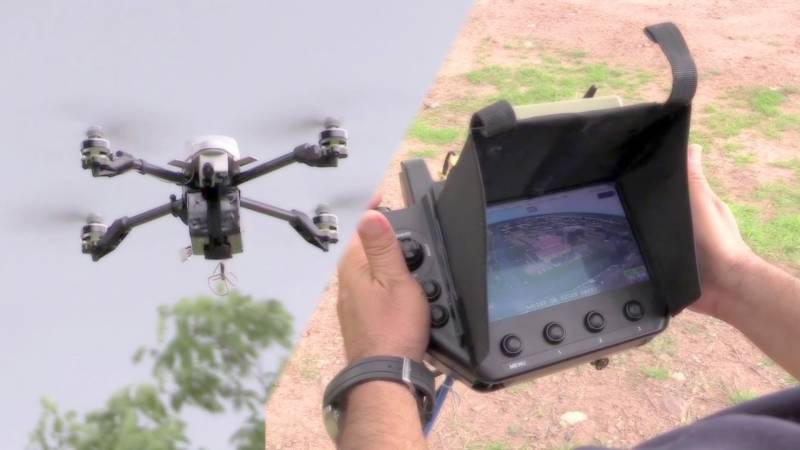
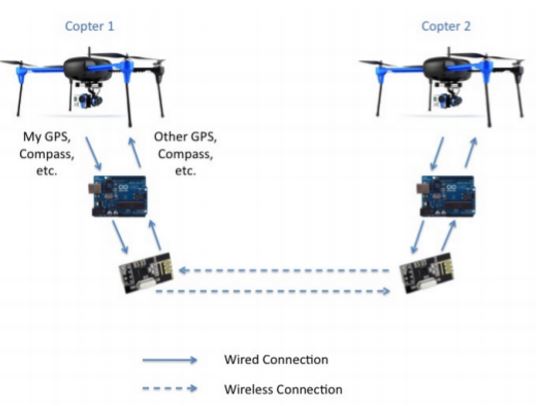
→ LOCUST - Swarming Navy Drones
→ Pentagon successfully tested a swarm of 103 drones
→ Intel ran a drone show during Lady Gaga’s break in the US Super Cup
For UAVs, the negative from the inverse square law (isotropic-emitting antenna) partially “compensates” the antenna beam width and the diagram directivity:
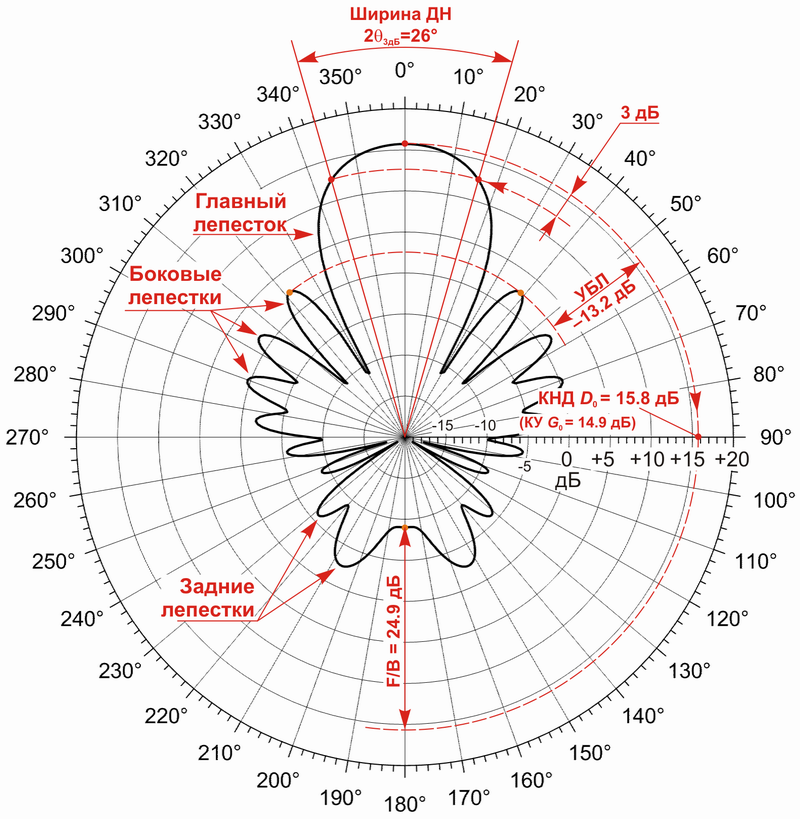
After all, an airborne radar in a pulse can give out under 17 kW of EMP energy.
This is not cellular communications — where the cell should provide 360 degrees connectivity to end elements.
Let's say this variation:
The carrier aircraft (for Perdix) this F-18 has (now) AN / APG-65 radar:

maximum average radiated power of 12,000 watts
or in the future it will have AN / APG-79 AESA: it
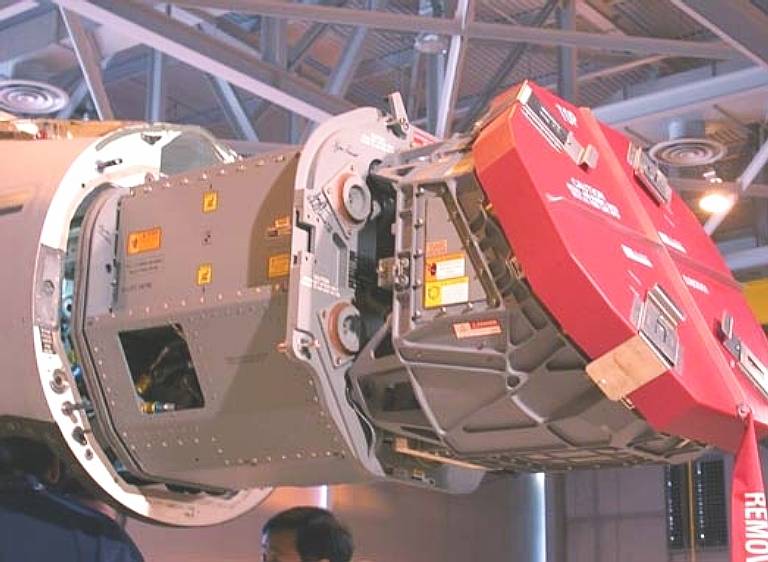
must emit EMI energy under 15 kW in pulse.
This is enough to extend the active life of Perdix Micro-Drones from the current 20 minutes to an hour, or maybe more.
Most likely, the intermediate drone Perdix Middle will be used, which will be irradiated at a sufficient distance by the radar of the fighter, and he, in turn, will "distribute" energy to the younger brothers Perdix Micro-Drones via PoWiFi / PoWiMax, while exchanging information with them (flight and flight, targets, swarm coordination).
Perhaps soon it will come to charging cell phones and other mobile devices that are in the range of Wi-Fi, Wi-Max or 5G?
Afterword: 10-20 years, after the widespread introduction in everyday life of numerous microwave electromagnetic emitters (Mobile phones, Microwaves, Computers, WiFi, Blu tools, etc.) suddenly cockroaches in big cities suddenly turned into a rarity! Now a cockroach is an insect that can be found only in a zoo. They suddenly disappeared from the houses they used to love.

CARL Cockroaches!
These monsters, the leaders of the list of “radioresistant organisms,” shamelessly capitulated!
Help
LD 50 - the average lethal dose, that is, the dose kills half of the organisms in the experiment; LD 100 - a lethal dose kills all organisms in the experiment.
Who is next in line?
The permissible radiation levels of mobile base stations (900 and 1800 MHz, the total level from all sources) in the sanitary-residential zone in some countries differ markedly:
Ukraine: 2.5 μW / cm². (the most stringent sanitary standard in Europe)
Russia, Hungary: 10 μW / cm².
Moscow: 2.0 μW / cm². (the norm existed until the end of 2009)
USA, Scandinavian countries: 100 μW / cm².
The temporary permissible level (VDU) from mobile radiotelephones (MRI) for users of radiotelephones in the Russian Federation is 10 μW / cm² (Section IV - Hygienic requirements for mobile land radio stations SanPiN 2.1.8 / 2.2.4.1190-03 "Hygienic requirements for placement and operation land mobile radio communications " ).
In the USA, the Certificate is issued by the Federal Communications Commission (FCC) for cellular devices with a maximum SAR level of not more than 1.6 W / kg (and the absorbed radiation power is reduced to 1 gram of human organ tissue).
In Europe, according to the international directive of the Commission for the Protection against Non-ionizing Radiation (ICNIRP), the SAR value of a mobile phone must not exceed 2 W / kg (while the absorbed radiation power is converted to 10 grams of human organ tissue).
More recently, in the UK, a safe level of SAR was considered to be 10 W / kg. A similar picture was observed in other countries.
The maximum SAR value adopted in the standard (1.6 W / kg) cannot even be reliably attributed to “hard” or “soft” standards.
Accepted in both the United States and Europe, standards for determining the SAR value (all rationing of microwave radiation from cell phones, which we are talking about are based only on the thermal effect, that is, associated with the heating of human organs).
FULL CHAOS.
Medicine has not yet given a clear answer to the question: is mobile / WiFi harmful and how much?
And what will happen with the wireless transmission of electricity by microwave technology?
Here, the power is not watts and miles of watts, but already kW ...
Note: A typical WiMAX base station emits a power of approximately +43 dBm (20 W), and a mobile communication station usually transmits +23 dBm (200 mW).
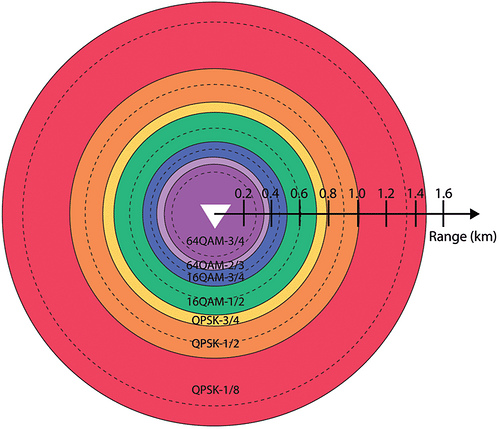
Used documents, photos and videos
“RADIO ELECTRONICS MAGAZINE” N 12, 2007 (ELECTRIC POWER FROM SPACE- SOLAR SPACE POWER PLANTS, V. A. Vanke)
“Microwave Electronics - Perspectives in Space Power Engineering” V. Vanke, Doctor of Physics and Mathematics
www.nasa.gov
www.whdi.org
www.defense.gov
www.witricity.com
www.ru.pinterest.com
www.raytheon.com
www.ausairpower.net
www.wikipedia.org
www.slideshare.net
www.homes .cs.washington.edu
www.dailywireless.org
www.digimedia.ru
www.powercoup.by
www.researchgate.net
www.proelectro.info
www.youtube.com
“Microwave Electronics - Perspectives in Space Power Engineering” V. Vanke, Doctor of Physics and Mathematics
www.nasa.gov
www.whdi.org
www.defense.gov
www.witricity.com
www.ru.pinterest.com
www.raytheon.com
www.ausairpower.net
www.wikipedia.org
www.slideshare.net
www.homes .cs.washington.edu
www.dailywireless.org
www.digimedia.ru
www.powercoup.by
www.researchgate.net
www.proelectro.info
www.youtube.com
